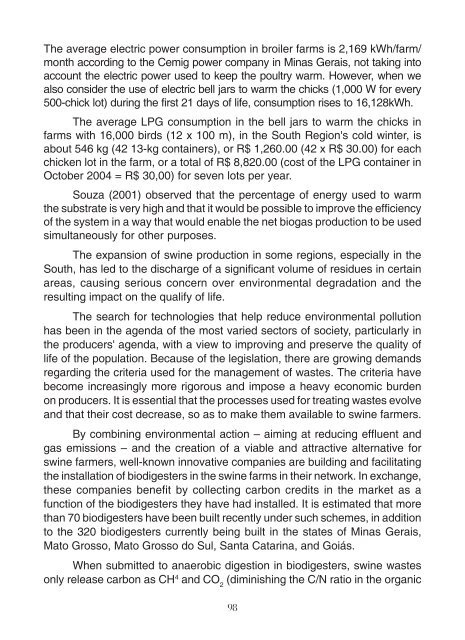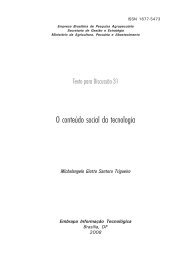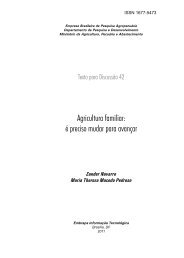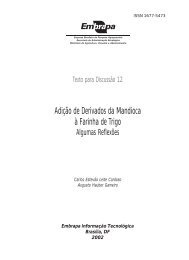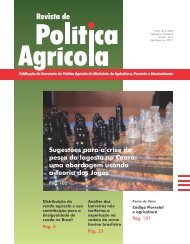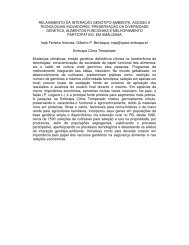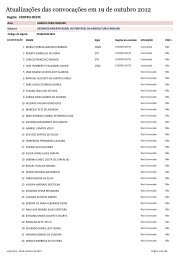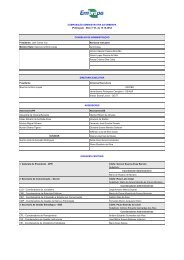Ministry of Agriculture, Livestock and Food Supply - Embrapa
Ministry of Agriculture, Livestock and Food Supply - Embrapa
Ministry of Agriculture, Livestock and Food Supply - Embrapa
You also want an ePaper? Increase the reach of your titles
YUMPU automatically turns print PDFs into web optimized ePapers that Google loves.
The average electric power consumption in broiler farms is 2,169 kWh/farm/<br />
month according to the Cemig power company in Minas Gerais, not taking into<br />
account the electric power used to keep the poultry warm. However, when we<br />
also consider the use <strong>of</strong> electric bell jars to warm the chicks (1,000 W for every<br />
500-chick lot) during the first 21 days <strong>of</strong> life, consumption rises to 16,128kWh.<br />
The average LPG consumption in the bell jars to warm the chicks in<br />
farms with 16,000 birds (12 x 100 m), in the South Region's cold winter, is<br />
about 546 kg (42 13-kg containers), or R$ 1,260.00 (42 x R$ 30.00) for each<br />
chicken lot in the farm, or a total <strong>of</strong> R$ 8,820.00 (cost <strong>of</strong> the LPG container in<br />
October 2004 = R$ 30,00) for seven lots per year.<br />
Souza (2001) observed that the percentage <strong>of</strong> energy used to warm<br />
the substrate is very high <strong>and</strong> that it would be possible to improve the efficiency<br />
<strong>of</strong> the system in a way that would enable the net biogas production to be used<br />
simultaneously for other purposes.<br />
The expansion <strong>of</strong> swine production in some regions, especially in the<br />
South, has led to the discharge <strong>of</strong> a significant volume <strong>of</strong> residues in certain<br />
areas, causing serious concern over environmental degradation <strong>and</strong> the<br />
resulting impact on the qualify <strong>of</strong> life.<br />
The search for technologies that help reduce environmental pollution<br />
has been in the agenda <strong>of</strong> the most varied sectors <strong>of</strong> society, particularly in<br />
the producers' agenda, with a view to improving <strong>and</strong> preserve the quality <strong>of</strong><br />
life <strong>of</strong> the population. Because <strong>of</strong> the legislation, there are growing dem<strong>and</strong>s<br />
regarding the criteria used for the management <strong>of</strong> wastes. The criteria have<br />
become increasingly more rigorous <strong>and</strong> impose a heavy economic burden<br />
on producers. It is essential that the processes used for treating wastes evolve<br />
<strong>and</strong> that their cost decrease, so as to make them available to swine farmers.<br />
By combining environmental action – aiming at reducing effluent <strong>and</strong><br />
gas emissions – <strong>and</strong> the creation <strong>of</strong> a viable <strong>and</strong> attractive alternative for<br />
swine farmers, well-known innovative companies are building <strong>and</strong> facilitating<br />
the installation <strong>of</strong> biodigesters in the swine farms in their network. In exchange,<br />
these companies benefit by collecting carbon credits in the market as a<br />
function <strong>of</strong> the biodigesters they have had installed. It is estimated that more<br />
than 70 biodigesters have been built recently under such schemes, in addition<br />
to the 320 biodigesters currently being built in the states <strong>of</strong> Minas Gerais,<br />
Mato Grosso, Mato Grosso do Sul, Santa Catarina, <strong>and</strong> Goiás.<br />
When submitted to anaerobic digestion in biodigesters, swine wastes<br />
only release carbon as CH 4 <strong>and</strong> CO 2 (diminishing the C/N ratio in the organic<br />
98


